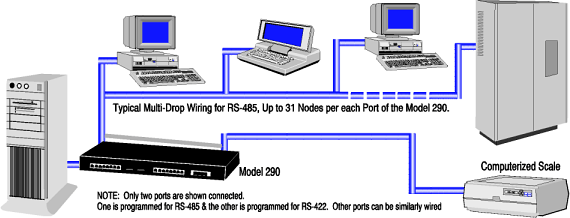
The RS-485 interface is often found in environments where networks are
configured to support a polling type of operation, a 'query-response'
communication from a 'master' central computer to 'slave' terminals or
other data devices. An example of this may be found in the factory
setting where a master computer is controlling different machine tools
involved in the manufacturing process, querying them on the status of a
job and issuing resulting controls. Another example may be found in the
retail store setting, the grocery or department store. Here the master
computer may query Point of Sale terminals for status, receive back the
status of just completed sale and then appropriately adjust the
inventory data base.
Often in the same environments are found master computers communicating
with other data devices using the RS-422 interface. Why? Generally, the
electrical interference present drives the communication to certain
devices to this interface since it will give them greater protection
through its use of differential signaling.
There is thus a general need to configure networks for the local
environment that can accommodate both RS-485 and RS-422 communications.
The Model 290 was designed to do this and even more. It is a
concentrator, 'hanging' off of the central computer and allowing it to
communicate with either RS-422 or RS-485 data devices. However, it
pushes the RS-485 networking capability well beyond what is usually
encountered. Typically, the master can only communicate with up to 32
devices on an RS-485 network. The Model 290 allows this to be expanded
to support up to 496 nodes on the network.
The accompanying illustration shows the Model 290 in an application. The
unit has 16 ports, although only two ports are shown in the diagram.
Each port can be set, that is programmed, as either a 4 wire RS-422 or a
2 wire RS-485. This allows the Model 290 to be used to configure the
hybrid RS-485-RS-422 network. The illustration shows the master,
centralized computer with a 2 branch network. In the upper branch, the
Model 290 is allowing it to communicate with 3 PCs and another computer
from a single port using the RS-485 protocol. This is nothing. Each port
of the Model 290 in the RS-485 mode of operation can support up to 31
connected data devices. In the lower branch, the Model 290 is allowing
the master to communicate with a computerized scale using the RS-422
interface. This scale may be in a particularly harsh environment of a
store, the meat department for instance, where motorized slicing
equipment may continuously generate electrical interference whose
effects RS-422 communication can ameliorate.
As a further bonus all of the ports of the Model 290 are isolated and
have surge protection. Consequently the hybrid networks are protected
against inaccuracies from ground loops and destruction from lightning
and other surges.
|


